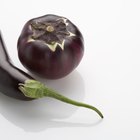
Not all oregano is the same. European oregano, also known as Greek oregano, Turkish oregano and Mediterranean oregano, comes from one plant while Mexican oregano comes from another. Their flavors are different, too. So why are they both called oregano? Although their tastes are distinct, they do share some flavor notes in common -- and when dried, they're almost indistinguishable by sight. You shouldn't really consider them interchangeable, though.
Old World Oregano
Mediterranean oregano comes from a plant native to the shores of the Mediterranean sea named Origanum vulgare. It's part of the mint family and very similar to marjoram in flavor. Pungent and peppery, Mediterranean oregano has a sweet anise undertone.
New World Oregano
Mexican oregano, also occasionally called Cuban or Puerto Rican oregano, comes from a plant named Lippia graveolens that is native to Central and South America. Its closest relative is lemon verbena. Its dominant notes are also pungent, but it carries more floral and grassy notes.
Uses of Mediterranean Oregano
Use Mediterranean oregano in any dish from that region, from spaghetti sauce and pizza to leg of lamb and grilled fish. Oregano is a good match for sauteed bell peppers, white beans and Greek salad. Try cooking it with potatoes and lemon as well.
Uses of Mexican Oregano
Mexican oregano is widely used in Mexican cuisine; as its alternate names imply, it also makes an appearance in Cuban and Puerto Rican dishes. Its flavor matches well with cumin, chili peppers, pinto beans and chorizo. Use it to flavor chili, braised or roasted pork and tortilla soup.
Related Articles

Classic Russian Spices

What Herbs & Spices Flavor Fish?

Difference Between Peppermint Extract & ...

Afghan Spices

Salmon Dinner Menu
Good Spices to Put on Tilapia When ...

A Substitute for Japanese Parsley

How to make Stuffed Jalapeno Peppers ...

How to Grill a Cod Fish

Basil for Hair Growth

How to Cook Hog Fish

Nigerian Herbs & Spices

Low-Calorie Lebanese Food

Thai Herbal Ball Massage Ingredients

How to Cook Raw Tuna in Lemon

What Herbs Go With Veal Chops?

How to Crush Basil
Homemade Pico de Gallo Recipe

How to Make Rubbed Sage

How to Cook Sole Fillets With Butter ...
References
- The Kitchn: Oregano -- Mediterranean and Mexican
- The Chicago Tribune: Oregano Origins Can Matter
- Handbook of Spices, Seasonings, and Flavorings: Susheela Raghavan
- The Flavor Bible: Karen Page and Andrew Dornenburg
Writer Bio
Lori A. Selke has been a professional writer and editor for more than 15 years, touching on topics ranging from LGBT issues to sexuality and sexual health, parenting, alternative health, travel, and food and cooking. Her work has appeared in Curve Magazine, Girlfriends, Libido, The Children's Advocate, Decider.com, The SF Weekly, EthicalFoods.com and GoMag.com.
Photo Credits
Jupiterimages/liquidlibrary/Getty Images